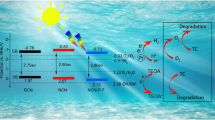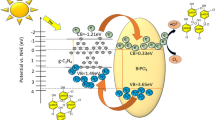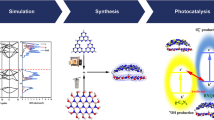Abstract
Photocatalytic water splitting with simultaneous degradation of organic pollutants is an effective strategy to alleviate the increasingly serious energy and environmental crisis. However, the photocatalytic activity is restricted by the high charge recombination rate and limited sunlight utilization. Herein, black phosphorus (BP) with a broad sunlight response range was utilized as a photosensitizer to enhance the photocatalytic performance of the Au/carbon nitride (CN) heterostructure. The as-prepared BP/Au/CN exhibited a significantly enhanced H2 generation rate of 1400.8 µmol h−1 g−1 under UV-vis light irradiation, which is almost 70 times higher than that of bare CN and BP/CN and 2 folds higher than that of the Au/CN heterojunction. Specifically, the optimal BP/Au/CN sample presented a waste-to-hydrogen production rate of 195.8 µmol h−1 g−1 with the degradation of bisphenol A, verifying the synergistic effect of the ternary heterojunction. The photocatalytic mechanism was systematically studied by the combination of experiments and theoretical calculations. The improved photocatalytic performance was derived from the overall sunlight absorption ability of BP, effective electron transfer media and plasmonic character of Au nanoparticles, as well as the matched work function and strong interaction of the three components. A unidirectional electron transfer from BP to Au and then to CN was established, which effectively improved the charge transfer capability, resulting from the appropriate Ohmic contact of Au and BP and the Schottky barrier constructed in Au/CN hybrid.
摘要
光催化废水产氢技术是缓解日益严峻的能源和环境危机的有效方法. 然而, 由于载流子复合率较高、太阳光利用率较低, 目前光催化活性仍然难以满足工业发展的需要. 基于以上问题, 本文设计了具有全谱太阳光响应的黑磷敏化的金/氮化碳(BP/Au/CN)异质结光催化剂, 该三元异质结可以在实现降解双酚A的同时, 将水分解为氢气, 其光催化产氢活性可达到195.8 µmol h−1g−1. 此外, 在紫外-可见光照射下, BP/Au/CN的光催化产氢活性可以达到1400.8 µmol h−1g−1, 是CN或BP/CN样品的近70倍, Au/CN异质结的2倍. 光催化活性的提高表明异质结中三种元素具有良好的协同作用. 本文将一系列实验表征与理论计算相结合, 对BP/Au/CN的光催化机理进行了系统研究. 结果表明, 黑磷的全谱太阳光吸收能力、金的电子传输介质作用以及三种材料匹配的功函数是其光催化活性提高的关键因素. 此外, 通过金和黑磷的欧姆接触以及Au/CN杂化体系中肖特基异质结的构筑, 实现了电子从黑磷到金,再到氮化碳的单向转移, 从而提高了载流子的传输性能.
Similar content being viewed by others
References
Liu M, Chen Y, Su J, et al. Photocatalytic hydrogen production using twinned nanocrystals and an unanchored NiSx co-catalyst. Nat Energy, 2016, 1: 16151
Liu Y, Li X, Zhang Q, et al. A general route to prepare low-ruthenium-content bimetallic electrocatalysts for pH-universal hydrogen evolution reaction by using carbon quantum dots. Angew Chem Int Ed, 2020, 59: 1718–1726
Chen S, Liao J, Zhou Z, et al. Boosting photocatalytic hydrogen evolution using a noble-metal-free co-catalyst: CuNi@C with oxygen-containing functional groups. Appl Catal B-Environ, 2021, 291: 120139
Calipari ES, Godino A, Peck EG, et al. Granulocyte-colony stimulating factor controls neural and behavioral plasticity in response to cocaine. Nat Commun, 2018, 9: 9
Turner SWD, Voisin N, Fazio J, et al. Compound climate events transform electrical power shortfall risk in the Pacific Northwest. Nat Commun, 2019, 10: 8
Jiang W, Zhao Y, Zong X, et al. Photocatalyst for high-performance H2 production: Ga-doped polymeric carbon nitride. Angew Chem Int Ed, 2021, 60: 6124–6129
Zhao Z, Xing Y, Li H, et al. Constructing CdS/Cd/doped TiO2 Z-scheme type visible light photocatalyst for H2 production. Sci China Mater, 2018, 61: 851–860
Zhao Z, Zhang X, Zhang G, et al. Effect of defects on photocatalytic activity of rutile TiO2 nanorods. Nano Res, 2015, 8: 4061–4071
Chen T, Liu L, Hu C, et al. Recent advances on Bi2WO6-based photocatalysts for environmental and energy applications. Chin J Catal, 2021, 42: 1413–1438
Liu L, Huang H, Chen Z, et al. Synergistic polarization engineering on bulk and surface for boosting CO2 photoreduction. Angew Chem Int Ed, 2021, 60: 18303–18308
Jiang XH, Wang LC, Yu F, et al. Photodegradation of organic pollutants coupled with simultaneous photocatalytic evolution of hydrogen using quantum-dot-modified g-C3N4 catalysts under visible-light irradiation. ACS Sustain Chem Eng, 2018, 6: 12695–12705
Nie YC, Yu F, Wang LC, et al. Photocatalytic degradation of organic pollutants coupled with simultaneous photocatalytic H2 evolution over graphene quantum dots/Mn-N-TiO2/g-C3N4 composite catalysts: Performance and mechanism. Appl Catal B-Environ, 2018, 227: 312–321
Zhou Z, Ng YH, Xu S, et al. A CuNi alloy-carbon layer core-shell catalyst for highly efficient conversion of aqueous formaldehyde to hydrogen at room temperature. ACS Appl Mater Interfaces, 2021, 13: 37299–37307
Chen Z, Li S, Peng Y, et al. Tailoring aromatic ring-terminated edges of g-C3N4 nanosheets for efficient photocatalytic hydrogen evolution with simultaneous antibiotic removal. Catal Sci Technol, 2020, 10: 5470–5479
Wang K, Xing Z, Du M, et al. Zinc sulfide quantum dots/zinc oxide nanospheres/bismuth-enriched bismuth oxyiodides as Z-scheme/type-II tandem heterojunctions for an efficient charge separation and boost solar-driven photocatalytic performance. J Colloid Interface Sci, 2021, 592: 259–270
Huo T, Ba G, Deng Q, et al. A dual strategy for synthesizing carbon/defect comodified polymeric carbon nitride porous nanotubes with boosted photocatalytic hydrogen evolution and synchronous contaminant degradation. Appl Catal B-Environ, 2021, 287: 119995
Wang S, Han X, Zhang Y, et al. Inside-and-out semiconductor engineering for CO2 photoreduction: From recent advances to new trends. Small Struct, 2021, 2: 2000061
Wei Z, Liu J, Shangguan W. A review on photocatalysis in antibiotic wastewater: Pollutant degradation and hydrogen production. Chin J Catal, 2020, 41: 1440–1450
Yang S, Zhang K, Ricciardulli AG, et al. A delamination strategy for thinly layered defect-free high-mobility black phosphorus flakes. Angew Chem, 2018, 130: 4767–4771
Zhu M, Zhai C, Fujitsuka M, et al. Noble metal-free near-infrared-driven photocatalyst for hydrogen production based on 2D hybrid of black phosphorus/WS2. Appl Catal B-Environ, 2018, 221: 645–651
Liu H, Hu K, Yan D, et al. Recent advances on black phosphorus for energy storage, catalysis, and sensor applications. Adv Mater, 2018, 30: 1800295
Hu J, Chen D, Mo Z, et al. Z-scheme 2D/2D heterojunction of black phosphorus/monolayer Bi2WO6 nanosheets with enhanced photocatalytic activities. Angew Chem Int Ed, 2019, 58: 2073–2077
Zhu M, Fujitsuka M, Zeng L, et al. Dual function of graphene oxide for assisted exfoliation of black phosphorus and electron shuttle in promoting visible and near-infrared photocatalytic H2 evolution. Appl Catal B-Environ, 2019, 256: 117864
Lei W, Mi Y, Feng R, et al. Hybrid 0D-2D black phosphorus quantum dots-graphitic carbon nitride nanosheets for efficient hydrogen evolution. Nano Energy, 2018, 50: 552–561
Zheng Y, Yu Z, Ou H, et al. Black phosphorus and polymeric carbon nitride heterostructure for photoinduced molecular oxygen activation. Adv Funct Mater, 2018, 28: 1705407
Kong L, Ji Y, Dang Z, et al. g-C3N4 loading black phosphorus quantum dot for efficient and stable photocatalytic H2 generation under visible light. Adv Funct Mater, 2018, 28: 1800668
Ran J, Guo W, Wang H, et al. Metal-free 2D/2D phosphorene/g-C3N4 van der Waals heterojunction for highly enhanced visible-light photocatalytic H2 production. Adv Mater, 2018, 30: 1800128
Yin S, Sun L, Zhou Y, et al. Enhanced electron-hole separation in SnS2/Au/g-C3N4 embedded structure for efficient CO2 photoreduction. Chem Eng J, 2021, 406: 126776
Zhu M, Cai X, Fujitsuka M, et al. Au/La2Ti2O7 nanostructures sensitized with black phosphorus for plasmon-enhanced photocatalytic hydrogen production in visible and near-infrared light. Angew Chem Int Ed, 2017, 56: 2064–2068
Cai X, Mao L, Yang S, et al. Ultrafast charge separation for full solar spectrum-activated photocatalytic H2 generation in a black phosphorus-Au-CdS heterostructure. ACS Energy Lett, 2018, 3: 932–939
Madhusudan P, Shi R, Xiang S, et al. Construction of highly efficient Z-scheme ZnxCd1−xS/Au@g-C3N4 ternary heterojunction composite for visible-light-driven photocatalytic reduction of CO2 to solar fuel. Appl Catal B-Environ, 2021, 282: 119600
Wang L, Hu Y, Qi F, et al. Anchoring black phosphorus nanoparticles onto ZnS porous nanosheets: efficient photocatalyst design and charge carrier dynamics. ACS Appl Mater Interfaces, 2020, 12: 8157–8167
Guan R, Wang D, Zhang Y, et al. Enhanced photocatalytic N2 fixation via defective and fluoride modified TiO2 surface. Appl Catal B-Environ, 2021, 282: 119580
Zhao Z, Wang D, Gao R, et al. Magnetic-field-stimulated efficient photocatalytic N2 fixation over defective BaTiO3 perovskites. Angew Chem Int Ed, 2021, 60: 11910–11918
Wang L, Zhou G, Tian Y, et al. Hydroxyl decorated g-C3N4 nanoparticles with narrowed bandgap for high efficient photocatalyst design. Appl Catal B-Environ, 2019, 244: 262–271
Zhou G, Li T, Huang R, et al. Recharged catalyst with memristive nitrogen reduction activity through learning networks of spiking neurons. J Am Chem Soc, 2021, 143: 5378–5385
Long L, Niu X, Yan K, et al. Highly fluorescent and stable black phosphorus quantum dots in water. Small, 2018, 14: 1803132
Gui Q, Zhu X, Liu L, et al. Identification of lattice oxygen in few-layer black phosphorous exfoliated in ultrahigh vacuum and largely improved ambipolar field-effect mobilities by hydrogenation and phosphorization. ACS Appl Mater Interfaces, 2017, 9: 39804–39811
Ji Q, Cheng X, Wu Y, et al. Visible light absorption by perylene diimide for synergistic persulfate activation towards efficient photodegradation of bisphenol A. Appl Catal B-Environ, 2021, 282: 119579
Shi W, Liu C, Li M, et al. Fabrication of ternary Ag3PO4/Co3(PO4)2/g-C3N4 heterostructure with following Type II and Z-scheme dual pathways for enhanced visible-light photocatalytic activity. J Hazard Mater, 2020, 389: 121907
Wang L, Guan R, Qi Y, et al. Constructing Zn-P charge transfer bridge over ZnFe2O4-black phosphorus 3D microcavity structure: Efficient photocatalyst design in visible-near-infrared region. J Colloid Interface Sci, 2021, 600: 463–472
Guo SQ, Zhang H, Hu Z, et al. Composition-dependent micro-structure and photocatalytic performance of g-C3N4 quantum dots@SnS2 heterojunction. Nano Res, 2021, 14: 4188–4196
Lv Y, Yue L, Khan IM, et al. Fabrication of magnetically recyclable yolk-shell Fe3O4@TiO2 nanosheet/Ag/g-C3N4 microspheres for enhanced photocatalytic degradation of organic pollutants. Nano Res, 2021, 14: 2363–2371
Zhang L, Meng G, Fan G, et al. High flux photocatalytic self-cleaning nanosheet C3N4 membrane supported by cellulose nanofibers for dye wastewater purification. Nano Res, 2021, 14: 2568–2573
Hou H, Zeng X, Zhang X. 2D/2D heterostructured photocatalyst: Rational design for energy and environmental applications. Sci China Mater, 2020, 63: 2119–2152
Fu Y, Shan Y, Zhou G, et al. Electric strain in dual metal Janus nanosheets induces structural phase transition for efficient hydrogen evolution. Joule, 2019, 3: 2955–2967
Shen R, Ren D, Ding Y, et al. Nanostructured CdS for efficient photocatalytic H2 evolution: A review. Sci China Mater, 2020, 63: 2153–2188
Zu M, Zhang S, Liu C, et al. Portable wastewater treatment system based on synergistic photocatalytic and persulphate degradation under visible light. Sci China Mater, 2021, 64: 1952–1963
Shi W, Li M, Huang X, et al. Facile synthesis of 2D/2D Co3(PO4)2/g-C3N4 heterojunction for highly photocatalytic overall water splitting under visible light. Chem Eng J, 2020, 382: 122960
Guo F, Huang X, Chen Z, et al. Construction of Cu3P-ZnSnO3-g-C3N4 p-n-n heterojunction with multiple built-in electric fields for effectively boosting visible-light photocatalytic degradation of broad-spectrum antibiotics. Separation Purification Tech, 2021, 265: 118477
Guo F, Huang X, Chen Z, et al. Formation of unique hollow ZnSnO3@ZnIn2S4 core-shell heterojunction to boost visible-light-driven photocatalytic water splitting for hydrogen production. J Colloid Interface Sci, 2021, 602: 889–897
Guo F, Chen Z, Huang X, et al. Cu3P nanoparticles decorated hollow tubular carbon nitride as a superior photocatalyst for photodegradation of tetracycline under visible light. Separation Purification Tech, 2021, 275: 119223
Liu E, Lin X, Hong Y, et al. Rational copolymerization strategy engineered C self-doped g-C3N4 for efficient and robust solar photocatalytic H2 evolution. Renew Energy, 2021, 178: 757–765
Li J, Cushing SK, Zheng P, et al. Solar hydrogen generation by a CdS-Au-TiO2 sandwich nanorod array enhanced with Au nanoparticle as electron relay and plasmonic photosensitizer. J Am Chem Soc, 2014, 136: 8438–8449
Acknowledgements
This work was supported by the National Natural Science Foundation of China (21801092, 21872001, and U1704140), the Program for the Development of Science and Technology of Jilin Province (20200801040GH), the Science and Technology Research Project of Henan Province (202102210055), the General project of Chinese postdoctoral program (2020M672263), the Key Research Programs in Universities of Henan Province (20A150031), and the Science and Technology Innovation Talent Support Program of Henan Province (19HASTIT034). Eceshi (https://www.eceshi.com) was acknowledged for the EPR analysis.
Author information
Authors and Affiliations
Contributions
Author contributions Wang L designed and engineered the samples; Sun Z conceived the post-fabrication tuning of random modes; Zhao Z and Qi Y performed the experiments; Zhou G wrote the paper with the support from Zhang F. All authors contributed to the general discussion.
Corresponding authors
Ethics declarations
Conflict of interest The authors declare no conflict of interest.
Additional information
Supplementary information Experimental details and supporting data are available in the online version of the paper.
Zaicheng Sun is a professor of Beijing Key Lab for Green Catalysis and Separation, Department of Chemistry and Biology, Faculty of Environment and Life, Beijing University of Technology. His research interests are mainly on the photocatalytic nanomaterials for water splitting, H2 production, and self-cleaning optical coating, as well as fluorescent carbon dots for theragnostics.
Supplementary information for
Rights and permissions
About this article
Cite this article
Wang, L., Qi, Y., Li, H. et al. Au/g-C3N4 heterostructure sensitized by black phosphorus for full solar spectrum waste-to-hydrogen conversion. Sci. China Mater. 65, 974–984 (2022). https://doi.org/10.1007/s40843-021-1833-1
Received:
Accepted:
Published:
Issue Date:
DOI: https://doi.org/10.1007/s40843-021-1833-1




